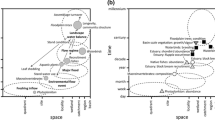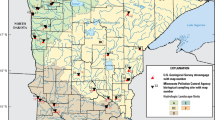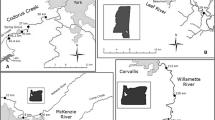Abstract
Although biomonitoring approaches are being increasingly used in the measurement of stream and river health, critical assumptions about the nature of biological populations and communities that underpin them are often ignored. Many approaches based on pattern detection in plant and animal communities assume high temporal persistence in the absence of anthropogenic disturbances. However, this has been rarely tested with long-term data sets and there is evidence that this assumption is not true in some river systems. Biological processes, such as predation and recruitment, can account for considerable spatial and temporal variation in the structure of some stream communities. These processes may prevent the development of robust predictive models or indices based on pattern detection. Measurements of population or community attributes also are often used to infer ecosystem processes, yet the link between pattern and process has rarely been demonstrated. Many goals of river management relate to the maintenance of natural ecological processes and ecosystem function; direct measurement of these processes is, however, often neglected in assessment programs. Such measures are often sensitive to causal factors that are known to affect river health and it is possible to develop simple but powerful predictive models. Perhaps more importantly, should an impact to be detected, strategies for remediation are more obvious as the causal processes are generally better known. The ultimate success of biomonitoring approaches depends on how well we understand the biophysical processes that influence the structure and dynamics of stream and river systems, and the way they function.
Similar content being viewed by others
References
Allan, J. D., 1983. Predator-prey relationships in streams. In: Barnes, J. R. & G. W. Minshall (eds), Stream Ecology: Application and Testing of General Ecological Theory Plenum Press, New York: 191–229.
Bott, T. L., J. J. Brock, C. S. Dunn, R. J. Naiman, R. W. Ovink & R. C. Peterson, 1985. Benthic community metabolism in four temperate stream systems: an inter-biome comparison and evaluation of the river continuum concept. Hydrobiologia 123: 3–45.
Bunn, S. E., 1995. Biological monitoring of water quality in Australian: workshop summary and future directions. Aust. J. Ecol. 20: 220–227.
Bunn, S. E. & P. M. Davies, 1990. Why is the stream fauna of southwestern Australia so impoverished? Hydrobiologia 194: 169–176.
Bunn, S. E. & J. M. Hughes, 1997. Dispersal and recruitment in streams: Evidence from genetic studies. J. N. am. Benthol. Soc. 16: 338–346.
Bunn, S. E., D. H. Edward & N. R. Loneragan, 1986. Spatial and temporal variation in the macroinvertebrate fauna of streams of the northern jarrah forest, Western Australia: community structure. Freshwat. Biol. 16: 67–92.
Bunn, S. E., P. M. Davies, D. M. Kellaway & I. Prosser, 1998. Influence of invasive macrophytes on channel morphology and hydrology in an open tropical lowland stream, and potential control by riparian shading. Freshwat. Biol. 39: 171–178.
Bunn, S. E., P. M. Davies & T. D Mosisch, 1999. Ecosystem measures of river health and their response to riparian and catchment degradation. Freshwat. Biol. 41: 333–345.
Chessman, B. C., 1995. Rapid assessment of rivers using macroinvertebrates: a procedure based on habitat-specific sampling, family level identification and a biotic index. Aust. J. Ecol. 20: 122–129.
Commonwealth of Australia, 1996. National Principles for the Provision of Water for Ecosystems. Occasional paper SWR No 3, Agriculture and Resource Management Council of Australia and New Zealand and Australian and New Zealand Environment and Conservation Council. ISBN 0 7310 2382 X.
Cooper, S. D., S. J. Walde & B. L. Peckarsky, 1990. Prey exchange rates and the impact of predators on prey populations in streams. Ecology 71: 1503–1514.
Council of Australian Governments, 1992. National Strategy for Ecologically Sustainable Development. Australian Government Printing Service, Canberra.
Cushing, C. E. & W. L. Gaines, 1989. Thoughts on recolonization of endorheic cold desert spring-streams. J. N. am. Benthol. Soc. 8: 277–287.
Davies, P. M., 1994. Ecosystem ecology of upland streams of the northern jarrah forest, Western Australia. Unpublished Ph.D. Thesis, Department of Zoology, The University of Western Australia, 236 pp.
Ebeling, A. W., S. J. Holbrook & R. J. Schmitt, 1990. Temporally concordant structure of a fish assemblage: bound or determined? Am. Nat. 135: 63–73.
Faith D. P., P. L. Dostine & C. L. Humphrey, 1995. Detection of mining impacts on aquatic macroinvertebrate communities: Results of a disturbance experiment and the design of a multivariate BACIP monitoring program at Coronation Hill, Northern Territory. Aust. J. Ecol. 20: 167–180.
Grossman, G. D., P. B. Moyle & J. O. Whitaker Jr., 1982. Stochasticity in structural and functional characteristics of an Indiana stream fish assemblage: a test of community theory. Am. Nat. 120: 423–454.
Hancock, M. A. & S. E. Bunn, 1997. Population dynamics and life history of Paratya australiensis Kemp, 1917 (Decapoda: Atyidae) in upland rainforest streams, southeast Queensland. Mar. Freshwat. Res. 48: 361–369.
Hildrew, A. G., 1992. Food webs and species interactions. In: Petts, G. & P. Calow (eds), The Rivers Handbook, Volume 1. Blackwell Science, London: 309–330.
Hildrew, A. G. & C. R. Townsend, 1987. Organization in freshwater benthic communities. In: Gee, J. H. & P. S. Giller (eds), Organization of Communities: Past and Present, Symposia of the British Ecological Society. Blackwell Scientific, Oxford: 347–371.
Hill, M. O., 1979. DECORANA-A FORTRAN Program for Detrended Correspondence Analysis and Reciprocal Averaging. Ecology and Systematics, Cornell University, Ithaca, New York.
Hughes, J. M., S. E. Bunn, D. Hurwood & M. Kingston, 1995. Genetic differentiation of populations of Paratya australiensis (Decapoda: Atyidae) in rainforest streams in south-east Queensland. J. N. am. Benthol. Soc. 14: 158–173.
Hughes, J. M., S. E. Bunn, D. A. Hurwood, S. Choy & R. Pearson, 1996. Genetic differentiation among populations of Caridina zebra (Decapoda: Atyidae) in tropical rainforest streams, northern Australia. Freshwat. Biol. 36: 289–296.
Hurlbert, S. H., 1997. Functional importance vs keystoneness: reformulating some questions in theoretical biocenology. Aust. J. Ecol. 22: 369–382.
Huryn, A. D. & J. B. Wallace, 1987. Local geomorphology as a determinant of macrofaunal production in a mountain stream. Ecology 68: 1932–1942.
Karr, J. R., 1991. Biological integrity: a long-neglected aspect of water resource management. Ecol. Appl. 1: 66–84.
Karr, J. R. & E. W. Chu, 2000. Sustaining living rivers. Hydrobiologia 422/423: 1–13.
Kay, W. R., M. J. Smith, A. M. Pinder, J. M. McRae, J. A. Davis & S. A. Halse, 1999. Patterns of distribution of macroinvertebrate families in rivers of north-western Australia. Freshwat. Biol. 41: 299–316.
Keast, A., 1981. Ecological Biogeography of Australia. Dr W. Junk Publishers, The Hague.
Mackay, R. J., 1992. Colonization by lotic macroinvertebrates: a review of processes and patterns. Can. J. Fish. aquat. Sci. 49: 617–628.
Miller, M. C. & J. R. Stout, 1989. Variability of macroinvertebrate community composition in an arctic and subarctic stream. Hydrobiologia 172: 111–127.
Mosisch, T. D. & S. E. Bunn, 1997. Temporal patterns in stream epilithic algae in response to discharge regime. Aquat. Bot. 58: 181–193.
Moyle, P. B. & B. Vondracek, 1985. Persistence and structure of the fish assemblage in a small California stream. Ecology 66: 1–13.
Naiman, R. J., 1983. The annual pattern and spatial distribution of aquatic oxygen metabolism in boreal forest watersheds. Ecol. Monogr. 53: 73–94.
Norris, R. H. & K. R. Norris, 1995. The need for biological assessment of water quality: Australian perspective. Aust. J. Ecol. 20: 1–6.
Petts, G. E., 2000. A perspective on the abiotic processes sustaining the ecological integrity of running waters. Hydrobiologia 422/423: 15–27.
Power, M. E., 1990. Effects of fish in river food webs. Science 250: 811–814.
Power, M. E., W. J. Matthews & A. J. Stewart, 1985. Grazing minnows, piscivorous bass, and stream algae: dynamics of a strong interaction. Ecology 66: 1448–1456.
Pringle, C. M., R. J. Naiman, G. Bretschko, J. R. Karr, M. W. Oswood, J. R. Webster, R. L. Welcomme & M. J. Winterbourn, 1988. Patch dynamics in lotic systems: the stream as a mosaic. J. N. am. Benthol. Soc. 7: 503–524.
Rapport, D. J., R. Costanza & A. J. McMichael, 1998. Assessing ecosystem health. Trends Ecol. Evol. 13: 397–402.
Resh, V. H., R. H. Norris & M. T. Barbour, 1995. Design and implementation of rapid assessment approaches for water resource monitoring using benthic macroinvertebrates. Aust. J. Ecol. 20: 108–121.
Sale, P. F., 1990. Recruitment of marine species: is the bandwagon rolling in the right direction? Trends Ecol. Evol. 5: 25–27.
Schaeffer, D. J., E. E. Henricks & H. W. Kerster, 1988. Ecosystem health: 1. Measuring ecosystem health. Envir. Manage. 12: 445–455.
Schofield, N. J. & P. E. Davies, 1996. Measuring the health of our rivers. Water (May/June): 39–43.
Smith, M. J., W. R. Kay, D. H. D. Edward, P. J. Papas, K. S. J. Richardson, J. C. Simpson, A. M. Pinder, D. J. Cale, P. H. J. Horwitz, J. A. Davis, F. H. Yung, R. H. Norris & S. A. Halse, 1999. AusRivAS: using macroinvertebrates to assess ecological condition of rivers in Western Australia. Freshwat. Biol. 41: 269–282.
Sousa, W. P., 1979. Disturbance in marine intertidal boulder fields; the non equilibrium maintenance of species diversity. Ecology 60: 1225–1239.
Storey, A. W., S. E. Bunn, P. M. Davies & D. H. Edward, 1990. Classification of the macroinvertebrate fauna of two river systems in south-western Australia in relation to physical and chemical parameters. Regul. Riv. 5: 217–232.
Surber, E. W., 1970. Procedure in taking stream bottom samples with the stream square foot bottom sampler. Proceedings of the 23rd Annual Conference of South East Game and Fisheries Commission 23: 587–591.
Suter, G. W., 1993. A critique of ecosystem health concepts and indexes. Envir. Toxicol. Chem. 12: 1533–1539.
Townsend, C. R., 1989. The patch dynamics concept of stream community ecology. J. N. am. Benthol. Soc. 8: 36–50.
Underwood, A. J. & P. G. Fairweather, 1989. Supply-side ecology and benthic marine assemblages. Trends Ecol. Evol. 4: 16–20.
Wallace, J. B., 1990. Recovery of lotic macroinvertebrate communities from disturbance. Envir. Manage. 15: 605–620.
Wallace, J. B., J. W. Grubaugh & M. R. Whiles, 1996. Biotic indices and stream ecosystem processes: results from an experimental study. Ecol. Appl. 6: 140–151.
Wicklum, D. & R. W. Davies, 1995. Ecosystem health and integrity. Can. J. Bot. 73: 997–1000.
Wright, J. F., 1995. Development and use of a system for predicting the macroinvertebrate fauna in flowing waters. Aust. J. Ecol. 20: 181–197.
Wright, J. F., D. Moss, P. D. Armitage & M. T. Furse, 1984. A preliminary classification of running water sites in Great Britain based on macroinvertebrate species and the prediction of community type using environmental data. Freshwat. Biol. 14: 221–256.
Zaret, T. M., 1982. The stability/diversity controversy: a test of hypotheses. Ecology 63: 721–731.
Author information
Authors and Affiliations
Rights and permissions
About this article
Cite this article
Bunn, S.E., Davies, P.M. Biological processes in running waters and their implications for the assessment of ecological integrity. Hydrobiologia 422, 61–70 (2000). https://doi.org/10.1023/A:1017075528625
Issue Date:
DOI: https://doi.org/10.1023/A:1017075528625




